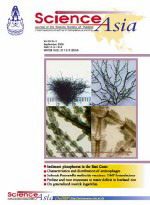ThaiScience
ThaiScience
SCIENCE ASIA
Volume 46, No. 06, Month DECEMBER, Year 2020, Pages 639 - 649
Cancer chemoresistance and therapeutic strategies targeting tumor microenvironment
Gayathri Heenatigala Palliyage, Rajib Ghosh, Yon Rojanasakul
Abstract Download PDF
Anticancer drug resistance, also known as a chemoresistance, continues to be the greatest challenge in cancer therapies. Chemoresistance is acquired during cancer treatment due to several mechanisms such as genetic alterations in the drug target, drug inactivation, and increased drug efflux from cancer cells. Therefore, a cure for cancer is challenging for most patients. The current focus on cancer research needs to be re-evaluated to resolve this issue. In recent years, many efforts have been devoted to understanding the interactions between malignant and non-malignant cells in the tumor microenvironment (TME) during cancer progression and treatment. Several TMEtargeted therapeutic strategies have been developed and utilized in clinical applications due to an increased recognition of TME as a key driver of tumor progression and chemoresistance. An additional challenge to effective cancer therapy is targeted delivery of therapeutic agents to the tumor site without harming surrounding healthy tissues and organs. The therapeutic efficacy of anticancer drugs is significantly hindered by non-specific biodistribution and low bioavailability of the drugs at tumor sites. In this regard, nanomedicines, including nanoparticle-based drug delivery systems, have been employed to improve the safety and efficacy of cancer therapeutics via TME targeting. This review provides a summary of the cellular components of TME, their roles in cancer progression and chemoresistance, and various TME-targeted therapeutic strategies and clinical trials.
Keywords
cancer, chemoresistance, tumor microenvironment, nanomedicineSCIENCE ASIA
Published by : The Science Society of Thailand
Contributions welcome at : http://www.scienceasia.org/
